
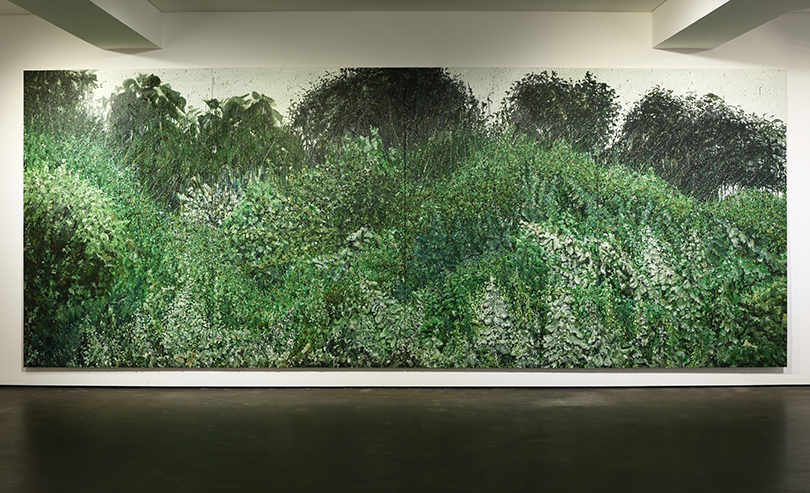
forest, 2015, oil on canvas, 227x 580cm
Image provided by artist
Courtesy of the artist
Jinyong Beom has mainly focuses on surrounding landscapes he has experienced himself. Beom’s work has been centered on this subject since he created the work titled Forest in 2015. In this work he delves into the landscape of reality, escaping from his previous practice of drawing scenes from his dreams. Both continuity and discontinuity from the previous works coexist here. Whereas the change in which the symbolic meaning and narrative of dreams are completely eliminated implies a disconnection, the attitude of compressing complex and nonlinear incidents and emotional turmoil experienced in dreams into a single frame of a painted canvas that connects to his current work where he transfers his experience to the plane of painting. Matters of pictorial composition and choice explored in the process, where the space in dreams with no beginning and end as well as with no entrance and exit moves to a single plane, also happen in the process in which the landscape of reality settles into a painting through in-depth thoughts and emotions.
Since 2015 Beom’s work has changed because he began to recognize painting that has the specificity of a window connected and away from reality. In other words, it is both a physical plane and a virtual world. Eventually, what matters to him is a question of how to reconstruct the reality that he has experienced and how to reinvent it in the context where it lives on forever in the painted plane.
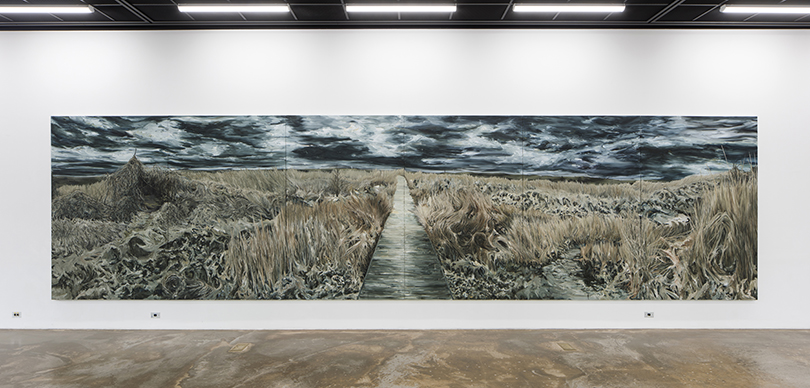
landscape, 2016, oil on canvas, 227x870cm
Image provided by artist
Courtesy of the artist
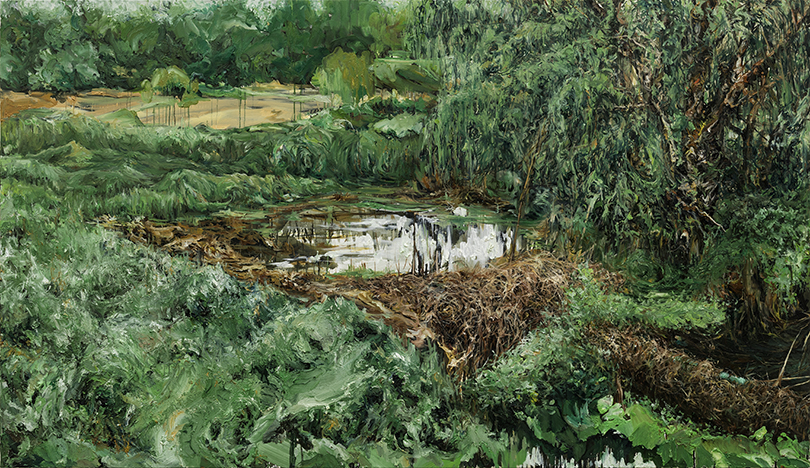
landscape, 2017, oil on canvas, 97x193.9cm
Image provided by artist
Courtesy of the artist
In his Landscape series painted in 2016, Beom chooses places that are neither closely connected to nor very far from our everyday lives, including abandoned parks, fields and hills. What he feels from such a setting is a distance which guarantees mental freedom while being connected to reality and which one can get by escaping from the banal ordinary frame or the burden of labor. Through this distance, Beom seems to find a location that helps him revive a sense of seeing the world as an artist and concentrate on what he has discovered. In this place where imagination and reality are maintained in a tense but balanced manner, he transforms the realistic landscape that he chooses into the pictorial landscape. Most of his works begin with scenes captured in the form of a photograph, but ultimately lead to another nature with a status independent from the facts included in the photo.
His choice of scenery consists of ordinary banal landscapes that are not specific to a certain place. Nevertheless, the landscapes that Beom draws upon show a kind of rich vividness. The ordinariness that the original object possesses attracts people’s attention more to the rich senses of the result of being painted. The absence of a dramatic narrative contained in the object makes the properties that the artist discovers, amplifies and sometimes newly creates from the object more vividly and more noticeably. Interestingly, however, these properties bring the eyes of viewers back to the original object chosen by the artist. For example, in Landscape (2017) the strokes of a brush showing the texture of sticky oil paint, while being delicate and entangled, portray the wild and strong vitality of ordinary weeds that nobody pays attention to more powerfully than in the photograph. These strokes of a brush unfold a new nature, which may be a permanently progressive object, on the plane, penetrating the innermost part of the object that is not well noticed in photo.
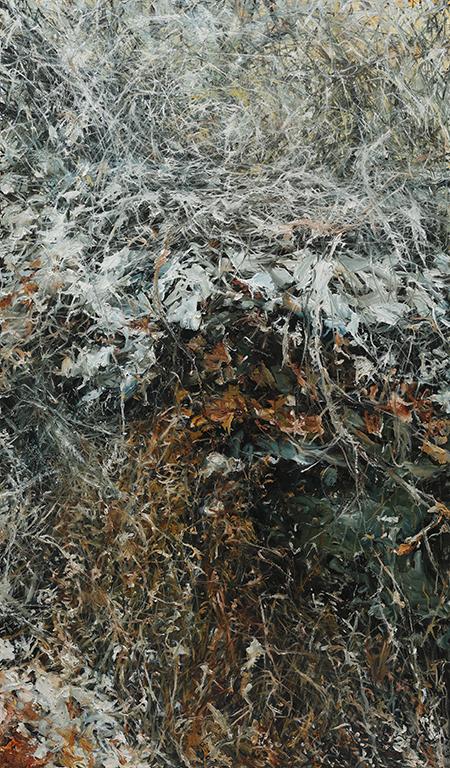
snowy day, 2019, oil on canvas, 193x97cm
Image provided by artist
Courtesy of the artist
The thing that most contributes to creating such a liveliness in Beom’s work are his touches. As he demonstrates in his Snowy Day series created in 2019 and 2020, Beom creates forms by accumulating lines and drawings with a variety of strong and weak rhythms, as if at times sharply penetrating inside and sliding upon the surface at other times. He intends to bring a liveliness across the whole canvas instead of a sense of a solid mass by making backgrounds and shapes ambiguous and penetrating each other, while not giving up the density of the object by constructing forms of countlessly accumulating lines. The important goal in his painting is probably that of capturing a lively and free energy, rather than the sense of a form in a stagnant state.
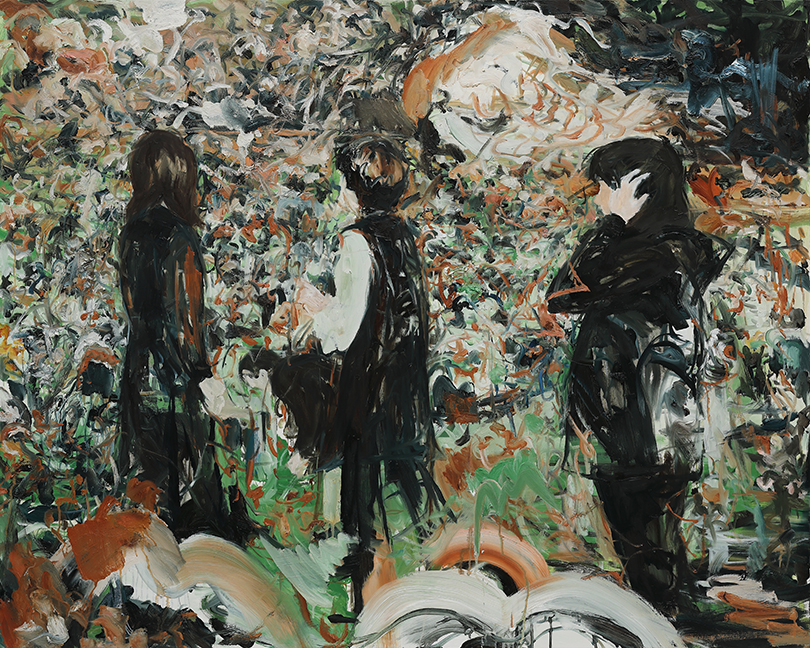
crow flower garden, 2020, oil on canvas,130x163cm
Image provided by artist
Courtesy of the artist
Recently, Beom began to include his family and acquaintances in his paintings; he treats the figures as part of the landscape rather than focusing on their individual forms or personalities. In Crow Flower Garden (2020) with figures more or less in front, the backsides of these figures dressed in black, connected to the background with flowers and grass forming an entanglement of various colors and lines, look like part of the flower garden as the title literally suggests. Beom constructs big and small masses elaborately through a line drawing of multiple colors ranging from white, red, green to black. He also creates an outstanding balance across the whole canvas by making space breathe into negative space created by intentionally slow strokes of a brush. With oil paint it is possible to paint over and express various textures depending on the brushstrokes. And these properties are inevitably interconnected with his style of work.
When I interviewed Jinyong Beom, he said, “I feel that the more I use my body, the better my painting turns out.” The touches carrying the rhythms of the body play an important role of synchronizing the feelings that the artist feels from the original landscape through the body. These are the eyes, hands and spirit of the painter who captures the vitality included in the landscape in a raw and natural state. Such touches invite viewers to feel the artist’s process of attempting to converge the vitality that the original object has to the truth on the plane of the painting, and to experience the passion sensed in this process in a state not to be separated from the density of the object realized in the completed work. This is the charm of painting. This is why I am looking forward to Jinyong Beom’s future paintings.
※ This content was first published in 『2021 SeMA Nanji Residency Program Catalogue』, and re-published here with the consent of SeMA Nanji Residency.
Lee Eunjoo
Lee Eunjoo received her PhD degree from Hongik University with a thesis titled "Changing Media and Contemporary Art in Korea: A Study onthe Korean Media Art (1960s-1970s)." She currently works as a curator at the National Museum of Modern and Contemporary Art, Korea, and adjunct professor at Hongik University. Her main research interests are print, photography, media art, and experimental art. Participating in the Korean Artist Digital Archive Project, she researched Kim Ku-lim, Lee Kangso, and Kang Kukjin and expanded her research to experimental art of Korea in the early 1960s and '70s. She served as the director at Art Space Gallery Jungmiso, an alternative art space, and also at Art Space Watt. She has curated various exhibitions, such as Visual Intersection.kr.nl (2009), Welcome to Media Space (2011), and TIME REALITY: disconnection, trace, oblivion (Coreana Museum of Art, 2019). She authored Post, Nam June Paik: Interview with 15 Media Artists in Korea (UP Press, 2016). Her other major publications include "A Study on Experimental Art and Media Art in 1960-1970s", "A Study of Lee Kangso's Experimental Art in the 1970s"and "Study on the Contemporary Characteristic of Printmaking in thePost Digital Media Era." She continues to curate and write about the phenomenon of genre fusion.


